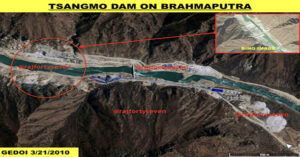
Source: Vinayak Bhat
New satellite imagery published by theprint.in shows a massive new dam on the Brahmaputra river — the YarlongTsangpo– in Tibet, nearly one kilometre long and apparently engulfing the entire water flow along its length.
The satellite imagery released on November 26 by DigitalGlobe, the United States commercial vendor of space imagery, shows evidence of a major new project located in Sangri county in southern Tibet, close to the border with Arunachal Pradesh.
The Brahmaputra, which rises in Tibet, is a major water source for the countries downstream and there has long been concern at China’s plans to exploit the water and the potential consequences of this for the millions of people downstream who rely on it for their livelihood, despite China’s assurances to India and Bangladesh that its dams were not designed for removing or storing water. India has full rights over the waters and in addition to concern about future loss of water supply there is the potential for catastrophe in the event of a sudden release of water from the dam in case of emergency.
The Indian government has, to date, not reported any evidence of water diversion although there have been reports in the news of the water turning black.
Another project, the Tsangpo or Zangmu Dam was constructed just 13 km downstream, becoming operational two years ago. Beijing paid no attention to India’s objections to this dam.
The feature in theprint.in reports speculation that this new, second dam is not purely to generate hydropower but to divert the water to supply the Taklamakan desert in Xinjian in northwestern China, 1,100 km to the northwest.
There is further concern about polymer resin adhesives which the satellite images show as being sprayed all around this project area to act as a dust suppressant. This is common for large construction projects but never near water asthese polymer resin adhesives are said to be harmful to humans and animals. Media reports suggest this could be the cause of the black water downstream in Assam.

Source: Vinayak Bhat
At the end of October the South China Morning Post(SCMP), the relatively independent Chinese newspaper, reported “experts involved in the project” as saying, “Chinese engineers are testing techniques that could be used to build a 1,000km tunnel – the world’s longest – to carry water from Tibet to Xinjiang”, and also reported a geotechnical engineer working on the project as saying that the tunnel would “turn Xinjiang into California”. The SCMP continued, “The earliest proposals to divert water from Tibet to Xinjiang were made by Qing dynasty officials Lin Zexu and ZuoZongtang in the 19th century. In recent decades, Chinese government branches, including the Ministry of Water Resources, have come up with engineering blueprints involving huge dams, pumps and tunnels.”
Responding to environmental concerns, the SCMP quotes Wang, an engineer on the project, as saying, “It won’t leave a mark on the surface for other countries or environmental activists to point their fingers at”. However, they also quote Zhou Shiqiao, a researcher at the Chinese Academy of Sciences’ Institute of Tibetan Plateau Research in Beijing, as saying, “It will change the landscape of an entire region…to my knowledge, no environmental evaluation has been carried out. The nature and scale of the impact remains in the dark.”
The Times of India reported at the end of November on China’s plans to build the world’s longest tunnel to divert water from the Brahmaputra to Xinjiang – China’s largest administrative division – and that this was raising concerns among environmentalists.
The Brahmaputra is sacred to both Tibetans and Indians. Its source is in the Angsi Glacier in Purang county in Tibet. Some studies have warned that the water supply from Tibet could run dry if global temperatures continue to rise.




 Print
Print Email
Email